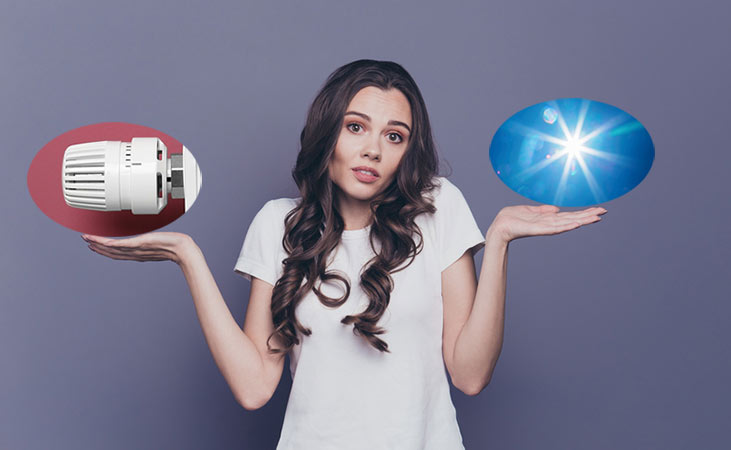You want a new distribution system for your heating system, but you don’t know whether to go with convection or radiant heat.
In this article we have summarized the main differences for you. The facts should inform you and serve your purchase decision.
1. difference: air vs. matter is heated!
One of the biggest differences is the way the room is heated. As soon as your distribution system works via convection, the air is heated in the process. Probably the best known device is the radiator. The radiator heats the surrounding air, which moves upwards to the ceiling as the temperature rises.
It behaves differently with radiant heating. It does not heat the air, but radiates the matter (people, furniture, etc.).
Temperature display can be confusing for you
Most often, the air temperature is used as a measure. However, this measurement can cause confusion for you.
If a room is heated with radiant heating, the matter is affected, but not the air. This quickly leads to the temperature reading being relatively high or low, even though the indoor climate feels very comfortable.
2nd difference: air circulation!
Convection heating ensures that the air circulates. As the temperature rises, the air moves upward toward the ceiling. There (as well as on cold walls), the air cools and, as it cools, sinks down to the floor, where it is reheated.
This process is crucial for the movement of air in the room.
With radiant heating, on the other hand, the process is only minimally noticeable. This is because the air is only heated to a small extent and thus there is hardly any air movement.
Note: Air circulation also means dust swirling! Especially for asthmatics and allergy sufferers, higher dust exposure can become a health challenge. However, all other residents are also at risk as a result. Therefore, you should pay very close attention to the type of distribution system for people who are already preloaded.
3. difference: insulation!
With convection heating, it is essential to insulate well. The reason is simple: the heated air would otherwise seek the way out!
At the same time, a large heat loss also means an increase in energy costs.
With radiant heating, insulation is less critical. Since it is essentially not the air that is heated, but the matter, less warm air can also escape.
Expensive investments in good insulation are therefore less necessary in this case.
Note: The situation is similar when the windows are open. In winter, with convection heating, it would be almost unthinkable to leave doors and windows open. This would cause a large amount of warm air to escape outside. Even shock ventilation is already energy-consuming.
Radiant heating is different: the exchange of air has little effect on the indoor climate. Unless there is a draft, for example, if windows and doors are open at the same time in several places in the room. If the draught is avoided, fresh air can be let in unhindered and the comfortable climate is maintained via the radiant energy of the surrounding matter.
4. difference: mold growth!
Mold can only develop when the following two conditions are met:
- a high humidity &
- a cold surface.
If one of the two points is missing, the mold has no chance!
Since a humidity level of 50-60% is considered healthy for humans, you should not try to bring this level down.
Rather, you should take care of the cold surfaces when preventing mold.
The colder the surface, the more susceptible it is to mold
With convection heating, the air is heated, but it often takes a long time until the walls are also heated. Especially in cold outdoor temperatures, it is difficult to heat up the exterior walls.
Unfortunately, this is often the reason why the mold then finds the best conditions to spread.
With radiant heating, the surfaces are tempered and illuminated from the outset. This ensures that there are no surface temperatures that are too cold. However, the same applies here: The larger the tempered surface, the lower the risk of mold!
Conclusion: convection heaters have long been replaced!
The differences between the two heating methods are clearly evident. In most cases, radiant heat comes out on top. If you’re looking to purchase a new distribution system, it’s important to be aware of what’s essential for you.
The number of installations of convection heaters has decreased sharply in recent years, and there is a reason for this. Experts increasingly advise to switch to radiant heating to benefit from its advantages.
Our panel heating works via radiant heat and is energy efficient. If you also want to benefit from energy-saving radiant heating, click here.
Yes, I would like to benefit from energy-saving radiant heating.
Photo: deagreez- fotolia.com



